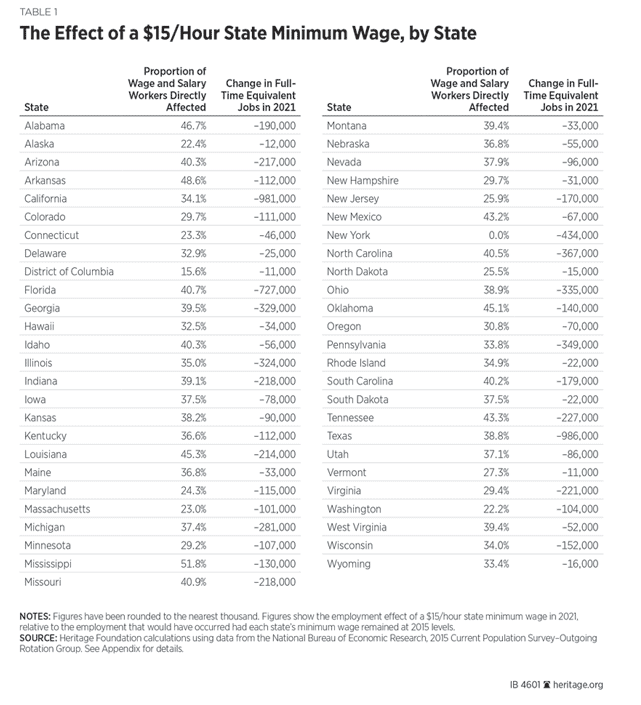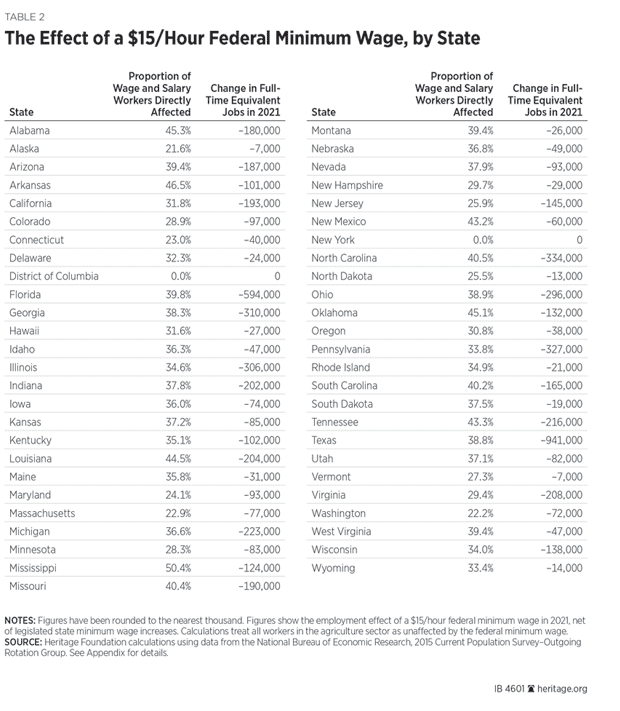
Including wages, payroll taxes and other withholdings, a $15 per hour employee must generate $38,700 annually in value to their employers “Such a high hurdle would make it much harder for less-experienced and less-skilled workers to find full-time jobs. Many of these workers are not yet productive enough to create that much value for their employers and businesses will not hire them at a loss,” according to Sherk.
Some companies may face closing or move outside the country. In Los Angeles, American Apparel slashed 500 jobs after the city’s $15/hr law took effect. The latimes says the Bureau of Labor Statistics data indicate local apparel manufacturing in Los Angeles County had fallen 33 percent since 2005 to 2,182, and employment in the industry had also declined the same percent, to 40,500 workers. Expensive real estate, the rising cost of materials and finding employees skilled enough who can afford to live in the city are definite challenges.

Studies by economists reveal an increase of ten percent in labor costs results in the loss of 6.8 percent less skilled workers in the long run. Although not an exact number, it does indicate the approximate level of job losses when wages increase.
The Washington Post reported in a study from Seattle where the minimum wage was mandated, researchers checking the numbers one way said the result was an increase in wages of $5.54/wk because of the increase, yet studying the numbers from a different angle results in a loss of $5.52/wk. Fewer workers had a job as the result of the minimum wage increase, and those that did, did not work as many hours as they had previously. The bottom line in Seattle: Earnings increased in one week sufficient to buy a Starbucks latte—until they raise the price or cut staff, which would increase wait time.
In a 40-hour week, $5.54 comes out to $0.14 per hour, which MHProNews understands means only nine percent of the increase in the minimum wage has effectively reached workers. “Ninety-one percent has dissipated in the need for businesses to counter the increased costs, either through reductions in hours or lost jobs. And that’s the best-case scenario,” said the study.

It’s not rocket science: If costs go up at one end, they have to be cut somewhere else, and this may be achieved by laying off other workers. In the industries most affected by a forced wage increase, cost competition is too significant to allow for price increases, so costs are cut elsewhere, often in labor.
In Sherk’s analysis, if the minimum wage was raised to $15/hr across the country, more than a tenth of all job losses would be in Texas, followed by 981,000 lost in California, 727,000 would disappear in Florida and 434,000 in New York.
When manufactured housing businesses consider the impact of polcies that didn’t work for Republican Richard Nixon, when he tried wage and price controls which failed, or for Democrats who propose it today, the study suggests the impact won’t be what supporters of $15 minimum wage seek. Rather, the law of supply and demand indicates that by increasing the demand for labor through private sector job creation is a better strategy. ##
(Photo credit: ebay–Lunch box and thermos)


























